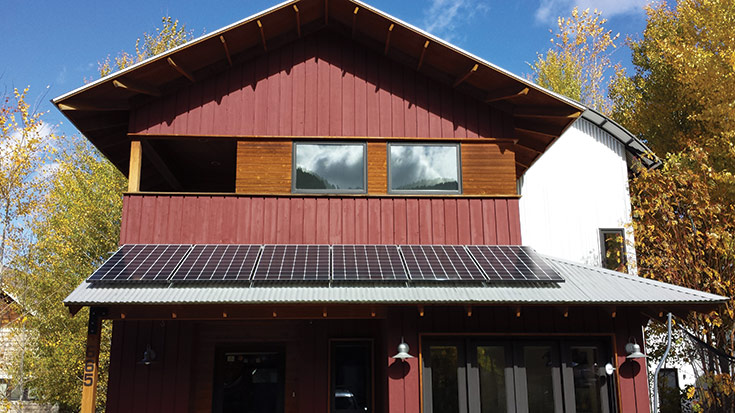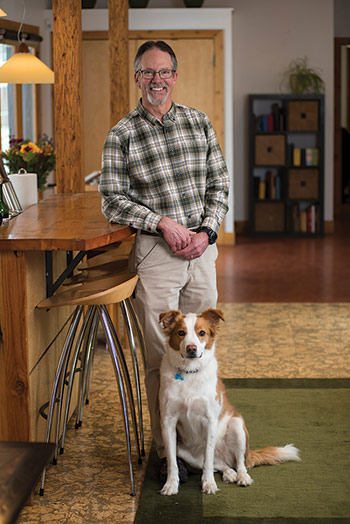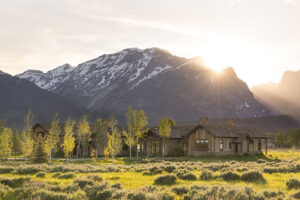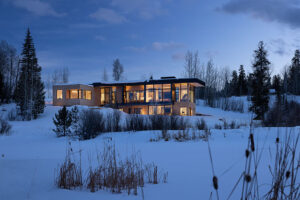Upgrading An Energy-efficient Home

Photos By Richard Reese + Latham Jenkins
Houses need health checkups too. Knowing this, architectural designer Richard Reese enlisted Scott Paulson of Resource Efficient Solutions to perform a physical exam of his 13-year-old home in east Jackson. Having designed the abode with energy efficiency in mind, Reese knew upgrades could be made to his “well-lived-in and well-loved” family home.
He met Paulson through a referral from Phil Cameron of Energy Conservation Works (ECW), a joint powers board that partners with the town of Jackson, Teton County, Lower Valley Energy and citizens to steward energy conservation in Jackson Hole. Through its no-interest home loan program, ECW has helped 100 homeowners valley-wide increase their energy efficiency.

compelled Richard Reese to do an intensive
energy audit of his 13-year-old east Jackson
home.
When Reese designed his home in 2003 (and hired John McIntosh of Snake River Builders to build it), he implemented the sustainable innovations he tracks at his eponymous Reese Design Studio. He used sustainable materials like cork, bamboo and marmoleum flooring, and Parallam beams. He bought bathtubs from Teton Habitat ReStore and sourced the reclaimed fir trim from an old agricultural building in Idaho. He chose foam insulation, high-grade windows and doors, and Energy Star appliances. He installed a heat-recovery ventilator, radiant heat and six solar panels (from Victor, Idaho-based solar provider Creative Energies) above the front porch.
Reese turned to Cameron after the second of his six photovoltaic solar panels failed last summer (the first failed because the glass on the panel shattered; the second short-circuited—a rare but known flaw in that model). Even for someone like Reese, who had made good decisions from the get-go, Cameron determined that a range of repairs and upgrades would help improve his home’s efficiency. “You don’t set it and forget it,” Cameron says. “The technology evolves and our understanding of the building science evolves. Everybody can do something to be more energy efficient, from behavioral changes to more significant investments.”
To start, Reese needed to examine his house’s health. Taking advantage of Lower Valley’s offer to split the cost of an intensive energy audit, he commissioned Paulson. The ensuing report was fascinating for the eco-minded Reese: a detailed analysis replete with geothermal imaging showing air leakage, resulting in a list of projects he could do himself, on weekends or when time allowed. Such nuance surprised him, especially after having approached the checkup as merely a means to fix his ailing solar array.
“The reality is that the best projects tend to be the least interesting,” Cameron says. “When it comes down to it, less glamorous steps—like plugging the holes, insulating the space, caulking your windows—can often save as much, if not more, energy than renewables.”
Reese considers these kinds of fixes to be intuitive yet instructive, like when your doctor tells you to stop eating chocolate cake. For instance, Paulson’s thermal imaging isolated cold spots where the weather stripping needed reinforcement. Other recommendations were more revelatory. For example, the placement of the game-meat freezer in the hot mechanical room made the freezer inefficient.
Combined with the new solar panels—a $10,000 investment subsidized by Lower Valley and paid off through Reese’s energy bill over five years—these seemingly minor repairs add up to a doubling of electricity savings. And the process itself produced little waste: Reese donated the four still-working original solar panels for reuse.
“The process opened my eyes to the notion that you can always take small steps,” Reese says. “You’re not stuck with your existing home.”
His home now has a new lease on life: “We’ve rounded the Monopoly board and are back on Go.”
YOU CAN DO IT
Energy Conservation Works (ECW) welcomes all inquiries related to energy conservation and emissions reductions. Whether clients are motivated to make their homes more comfortable or efficient, reduce their monthly bills, or do something good for the environment, ECW—working closely with Lower Valley Energy—helps them achieve their goals. “If we complete a project that hits one of those marks, it helps everyone,” says Phil Cameron, executive director of ECW. “As a cooperative utility, greater efficiency helps keep all of our rates low.”
Having just hit the 100th home loan milestone—a marker equivalent to a $750,000 community investment—ECW and Lower Valley will soon roll out a business-oriented loan program. “We’re taking the lessons we’ve learned from the 100 homes and doing the same thing for businesses,” Cameron says. Also in the works: a database of trade allies, as well as a series of training programs on timely topics like lighting and heating. To learn more about how ECW can help you improve the health of your home, visit energyconservationworks.org or call Cameron at (307) 732-8515.







